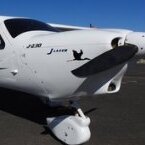Today I was messing around with multiple GPS antennas on active repeaters. they're really all active because most GPS antennas have amplifiers in them to cope with the lossy long thin cable.
had couple of antennas on the roof, fed with a power injector, and a few different rerad antennas.
I also updated the SW in my SE2 to 2.41
Started working with some ublox receivers I have with the very fancy U-center program that tells you all the backroom GPS data. then I moved to using the SE2.
It's clear why the SE2 will report some very poor position fixes. It's bar is very low. With NIC (Navigation integrity category) =0 and NACp (Navigation uncertainty category) = 6
(on the wifi GUI) the box shows GPS green.
If we ignore NIC of 0 means containment radius integrity is unknown. IE NFI !
The NACp of six means better than 566 m in horizontal and worse than 45m in vertical. (95% confidence)
So what I see (transmission of poor fixes) makes sense.
WHen life is good, I see up to NIC=6 and NACp = 8.
Now, this is much better - NACp of 8 implies better than 93m in H, but STILL > 45m in V . (95% confidence)
and containment radius better than 926m. The SIL for a SE2 is 1, which means likeihood of being beyond the containment radius is < 1 in 1000.
I've seen a NACp of 9, which implies better than 30m H and better then 45m in V
Now, what is accepted by receivers and processors and displayed online like flight aware and flight radar might be very different to what is displayed by ATC
IE ATC are unlikely to display poor NIC and NACp numbers (or shouldnt) . I wonder what SE2 pass to the EFB.
NACp is transmitted in ADSB message type 31 in V2. so the nav performance is transmitted.
So, of all this I think it is very practical to be able to provide a supplemental GPS antenna to a skyecho, so that the SE2 can be on some inside back window, and also have an aux GPS antenna on the window on the other wise of the aircraft.
I started with a log periodic wideband antenna and then made a little dipole antenna to gauge polarization matching sensitivity, and there is that to it. The antenna in the GPS receiver should be a circularly polarized type, but its a very very simple little thing and seems to be rather random but with a preference of paralell to the board axis.
Pictures to come





